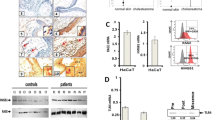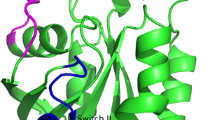Abstract
Ras-related C3 botulinum toxin substrate 1 (RAC1) is a 21-kDa signaling G protein that functions as a pleiotropic regulator of many cellular processes including epithelial differentiation. RAC1 activates the nicotinamide adenine dinucleotide phosphate oxidase complex which promotes formation of reactive oxygen species and degradation enzymes. RAC1 has been associated with rapid epithelial differentiation and invasive properties in human cholesteatoma. This study aimed to identify the presence of RAC1 in human cholesteatoma and analyze its functional role as a regulator of proteolysis and overgrowth. Tissue samples from human cholesteatoma and normal postaural skin were obtained from patients during otologic surgery for cholesteatoma. The expression of RAC1 mRNA was quantified by real-time RT-PCR, and localization of RAC1 expression was confirmed using immunohistochemical staining. Expression of RAC1 mRNA in the epithelium of cholesteatoma was significantly elevated 2.94 fold on average, compared with normal control skin. RAC1 expression in the suprabasal and basal layer of cholesteatoma epithelium was stronger than normal control skin. Our results suggest that RAC1 can be associated with rapid epithelial differentiation and invasive properties of human cholesteatoma.



Similar content being viewed by others
References
Boureux A, Vignal E, Faure S, Fort P (2007) Evolution of the Rho family of ras-like GTPases in eukaryotes. Mol Biol Evol 24:203–216
Bustelo XR, Sauzeau V, Berenjeno IM (2007) GTP-binding proteins of the Rho/Rac family: regulation, effectors and functions in vivo. Bioessays 29:356–370
Etienne-Manneville S, Hall A (2002) Rho GTPases in cell biology. Nature 420:629–635
Burridge K, Wennerberg K (2004) Rho and Rac take center stage. Cell 116:167–179
Nimnual AS, Taylor LJ, Bar-Sagi D (2003) Redox-dependent downregulation of Rho by Rac. Nat Cell Biol 5:236–241
Caron E (2003) Rac signalling: a radical view. Nat Cell Biol 5:185–187
Olszewska E, Wagner M, Bernal-Sprekelsen M, Ebmeyer J, Dazert S, Hildmann H (2004) Etiopathogenesis of cholesteatoma. Eur Arch Otorhinolaryngol 261:6–24
Laeeq S, Faust R (2007) Modeling the cholesteatoma microenvironment: coculture of hacat keratinocytes with ws1 fibroblasts induces mmp-2 activation, invasive phenotype, and proteolysis of the extracellular matrix. Laryngoscope 117:313–318
Nomura T, Sandilands A, Akiyama M, Liao H, Evans AT, Sakai K (2007) Unique mutations in the filaggrin gene in Japanese patients with ichthyosis vulgaris and atopic dermatitis. J Allergy Clin Immunol 119:434–440
Brown JH, Del Re DP, Sussman MA (2006) The Rac and Rho hall of fame: a decade of hypertrophic signaling hits. Circ Res 98:730–742
Hordijk PL (2006) Regulation of NADPH oxidases: the role of Rac proteins. Circ Res 98:453–462
Keely PJ, Westwick JK, Whitehead IP, Der CJ, Parise LV (1997) Cdc42 and Rac1 induce integrin-mediated cell motility and invasiveness through PI(3)K. Nature 390:632–636
Arkin M (2005) Protein-protein interactions and cancer: small molecules going in for the kill. Curr Opin Chem Biol 9:317–324
Kheradmand F, Werner E, Tremble P, Symons M, Werb Z (1998) Role of Rac1 and oxygen radicals in collagenase-1 expression induced by cell shape change. Science 280:898–902
Radisky DC, Levy DD, Littlepage LE, Liu H, Nelson CM, Fata JE (2005) Rac1b and reactive oxygen species mediate MMP-3-induced EMT and genomic instability. Nature 436:123–127
Acknowledgments
This work was supported by the National Research Foundation of Korea Grant funded by the Korean Government MEST, Basic Research Promotion Fund (NRF-2010-013-E00015). This study was supported by the Brain Korea Project 21, and the Institutes of Communication Disorder at Korea University.
Conflict of interest
The authors declare that they have no conflict of interest.
Author information
Authors and Affiliations
Corresponding author
Rights and permissions
About this article
Cite this article
Lee, N.H., Chang, JW., Choi, J. et al. Expression of Ras-related C3 botulinum toxin substrate 1 (RAC1) in human cholesteatoma. Eur Arch Otorhinolaryngol 270, 455–459 (2013). https://doi.org/10.1007/s00405-012-1966-y
Received:
Accepted:
Published:
Issue Date:
DOI: https://doi.org/10.1007/s00405-012-1966-y




